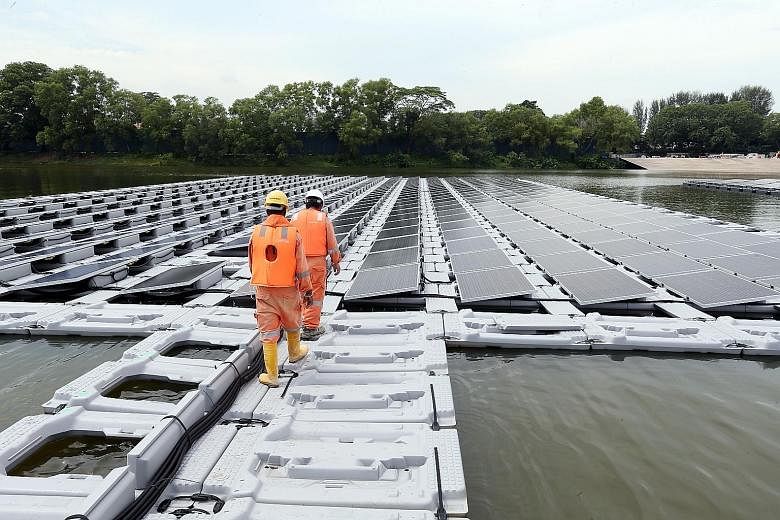The Tengeh Reservoir, out in the western reaches of Tuas, has acquired a space-age look, with thousands of dark blue squares now covering its tranquil surface.
These make up the world's largest floating solar-cell test bed - solar on steroids, if you will - an amalgam of 10 different systems which will, in December, begin to soak up the sun.
Over six months, the $11 million project the size of about 11/2 football fields will be studied for the performance and cost-effectiveness of the various systems. The power generated will also be sent to the grid, to fuel Singapore's electricity needs.
Announcing the initiative at the Asia Clean Energy Summit yesterday, Minister for the Environment and Water Resources Masagos Zulkifli said sustainability should not be considered as an alternative or a trade-off to economic development. "Rather, the pursuit of clean and renewable energy development is a venture into greater opportunities and growth, and also a necessary step into the green era," he said at the event in the Sands Expo and Convention Centre.
Each solar photovoltaic system, consisting of solar cells that can convert sunlight directly into energy, has a peak capacity of 100 kilowatts, enough to power 30 four-room HDB flats for a year. Over 150 sensors and other monitoring devices will capture the data to see which performs best. The floating system will also be compared against a rooftop system that has been laid on a building nearby.
Eventually, the two best floating systems will be chosen and placed on a larger trial of 1 megawatt peak capacity each, enough to power 300 four-room HDB flats for a year.
Three of the eight firms participating in the trial are local small and medium-sized enterprises, with the remaining five being international firms. Examples of systems being tested include one using solar cells that let in sunlight from both sides, and another that can be cooled with water pumped in from the reservoir to improve their performance.
The scientific evaluation will be conducted by the Solar Energy Research Institute of Singapore.
National water agency PUB will also look at the environmental impact on the reservoir, such as the effect on evaporation, water quality and biodiversity.
The Economic Development Board (EDB) and PUB initiative was initially meant to be operational by 2013, but met a three-year delay because of technical and logistical complexities that included securing the land and ensuring the electrical substation was big enough to accept the electricity generated.
Floating solar cells are looking increasingly attractive for Singapore to harness sunlight given limitations in roof space on land, and also their higher performance. Research suggests they can be up to 20 per cent more efficient than rooftop systems in tropical countries.
A side benefit is that they act as a blanket, lowering the evaporation of precious reservoir water.
Singapore's goal is to produce 350 megawatt peak of solar energy by 2020, enough to meet 5 per cent of the country's electricity needs. Currently, 95 per cent is fuelled by natural gas.
Mr Goh Chee Kiong, executive director for cleantech at EDB, said floating photovoltaic panels have caught on in the past year or two, in places like Japan, China, Europe and the United States. "It is a highly exportable know-how and sector that we want to groom, and we are seeing that through the strong interest by the various companies wanting to participate in the test bed in Singapore… including energy giants," he said.

